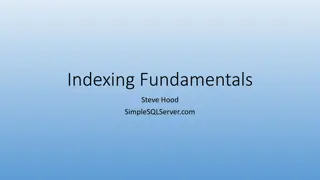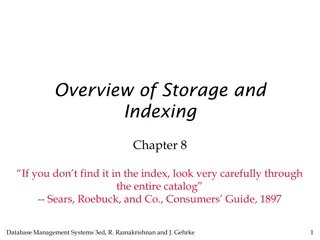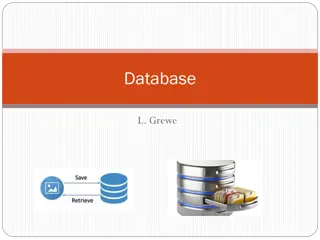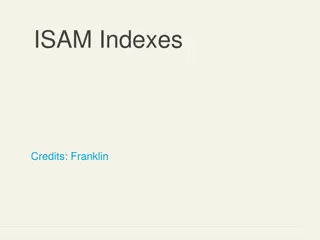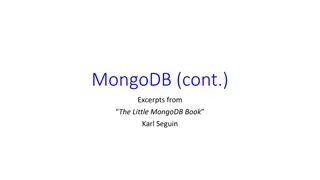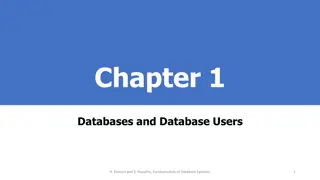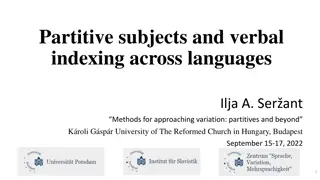Exploring NoSQL Database Scalability Using Indexing Techniques
Dive into the world of NoSQL database scalability by understanding how indexing enables richer queries and how local indexing impacts partitioning, updates, and lookups across distributed databases.
Download Presentation

Please find below an Image/Link to download the presentation.
The content on the website is provided AS IS for your information and personal use only. It may not be sold, licensed, or shared on other websites without obtaining consent from the author. Download presentation by click this link. If you encounter any issues during the download, it is possible that the publisher has removed the file from their server.
E N D
Presentation Transcript
Replex: A Multi-Index, Highly- Available Data Store Amy Tai* , Michael Wei*, Michael J. Freedman , Ittai Abraham*, Dahlia Malkhi* *VMware Research, Princeton University
SQL vs NoSQL Key-value stores Ex: HyperDex, Cassandra Ex: CockroachDB, Yesquel, H-Store NoSQL SQL NewSQL Rich querying model Simple, key-based querying No or limited transaction support Rich querying model Transaction support Transaction support Poor performance Scalable, high performance Scalable
SQL vs NoSQL Key-value stores Ex: HyperDex, Cassandra Ex: CockroachDB, Yesquel, H-Store NoSQL SQL NewSQL Rich querying model Simple, key-based querying No or limited transaction support Rich querying model Transaction support Transaction support Poor performance Scalable, high performance Scalable
NoSQL Scales with Database Partitioning col2 colc col col . . . 1 0 rows r[0] r[1] r[2] . . . r[c] default partitioning key
NoSQL Scales with Database Partitioning Partitions (with respect to the partitioning index)
How to enable richer queries without sacrificing shared- nothing scale-out?
Key Observations 1. Indexing enables richer queries
Local Indexing on the Partitioning Index col2 colc col1 col0 . . . select * where col0= foo Index updates are local Index lookups are local
Local Indexing Index stored locally at each partition col2 colc col1 col0 . . . insert (r[0] r[1] r[2] . . . r[c]) Index updates are local
Local Indexing Each partition builds a local index col2 colc col1 col0 . . . select * where col2= foo Index updates are local Index lookups must be broadcast to all partitions Potential synchronization across partitions
Global Indexing Distributed data structure spans all partitions col2 colc col1 col0 . . . insert (r[0] r[1] r[2] . . . r[c]) Index updates are multi-hop Index lookups executed on a single data structure
Key Observations 1. Indexing enables richer queries 2. Indexes more efficient if data is partitioned according to that index
Partitioning by Index Storage Overheads col2 colc col1 col0 . . . default partitioning key Partitioning by index must store data again
Partitioning by Index Storage Overheads col2 colc col1 col0 . . . default partitioning key Partitioning by index must store data again
Partitioning by Index Storage Overheads col2 colc col1 col0 . . . default partitioning key Partitioning by index must store data again
Partitioning by Index Storage Overheads col2 colc col1 col0 . . . default partitioning key HyperDex
Key Observations 1. Indexing enables richer queries 2. Indexes more efficient if data is partitioned according to that index 3. Rethink replication paradigm
Replex New replication unit: replex -- data replica partitioned and sorted with respect to an associated index replexes Serves data replication and indexing
Replex New replication unit: replex -- data replica partitioned and sorted with respect to an associated index replexes Replace data replicas with replexes Serves data replication and indexing
System Architecture col2 colc col0 col1 . . .
Inserts in Replex insert (r[0] r[1] r[2] . . . r[c]) ?
Partition Determined by a replexs Index insert (r[0] r[1] r[2] . . . r[c]) ?
Partition Determined by a replexs Index insert (r[0] r[1] r[2] . . . r[c]) ?
Partition Determined by a replexs Index insert (r[0] r[1] r[2] . . . r[c]) ?
Partition Determined by a replexs Index insert (r[0] r[1] r[2] . . . r[c])
Data Chains in Replex (x[0] x[1] x[2] . . . x[c]) (y[0] y[1] y[2] . . . y[c]) (z[0] z[1] z[2] . . . z[c]) Partitions in different replexes make up a data chain if they share rows
Data Chains in Replex All pairs of partitions are potential data chains
Main Challenge in Replex Increased failure complexity
Partition Failures 1. Partition Recovery 2. Client Requests Index is unavailable, data is available
Partition Failures Where is the data? Index is unavailable, data is available
Finding Data After Failure Client Requests Partition Recovery Tradeoff? Requests must be multicast Parallel Recovery Lookups reduce to linear scan at each partitions Recovery Time Request Amplification
Hybrid Replex: Key Contributions 1. Recovery time vs request amplification tradeoff 2. Improve failure availability of multiple replexes 3. Storage vs recovery performance tradeoff 4. Graceful failure degradation
Hybrid Replex: Key Contributions 1. Recovery time vs request amplification tradeoff 2. Improve failure availability of multiple replexes 3. Storage vs recovery performance tradeoff 4. Graceful failure degradation
Hybrid Replex: What is it? Shared across r replexes Not associated with an index Partitioning function dependent on these r replexes
Hybrid Replex hybrid replex
Data Chains with Hybrid Replex insert (r[0] r[1] r[2] . . . r[c])
Data Chains with Hybrid Replex insert (r[0] r[1] r[2] . . . r[c])
Data Chains with Hybrid Replex insert (r[0] r[1] r[2] . . . r[c]) ? ? ? ?
Data Chains with Hybrid Replex insert (r[0] r[1] r[2] . . . r[c])
1. Recovery time vs Request Amplification Recovery is less parallel but lower request amplification
Improving Failure Availability w/o Hybrid Replexes 2x Storage!
3. Storage vs. recovery performance 1.5x Storage! but worse client requests
Generalizing Hybrid Replexes k hybrid replexes may be shared across r replexes For the special case when r = 2, request amplification will be O(n1/(k+1)) For the special case when k = 1, request amplification will be O(n(r-1)/r)
Implementation Built on top of HyperDex, ~700 LOC Implemented partition recovery and request re-routing on failure Implemented variety of hybrid replex configurations
Evaluation 1. What is impact of replexes on steady-state performance? 2. How do hybrid replexes affect failure performance?
Evaluation Setup Table with two indexes 12 server machines, 4 client machines All machines colocated in the same rack, connected via 1GB head-of-rack switch 8 CPU, 16GB memory per machine
Systems Under Evaluation HyperDex Replex-2 Replex-3 Storage overhead: 2x Network hops per insert: 2 Failures Tolerated: 1 Storage overhead: 3x Network hops per insert: 3 Failures Tolerated: 2 Storage overhead: 6x Network hops per insert: 6 Failures Tolerated: 2









